
Sophie Pacek
Exercise Physiologist, Healthy Connections
I returned to my gym last week for the first time since its COVID-19 closure. It was great to get back into exercises that I was unable to do at home. Returning to movements I had not performed for a while coupled with the cooler mornings that winter brings meant that my body felt quite stiff and sore in the days following my first gym session. Many of you may have experienced similar sensations as you return to Healthy Connections, so I have put together a list of stretches to add to your cool-down or perform of a morning to reduce soreness and enhance mobility.
What are the benefits of stretching?
Winter stiffness is a thing. It can be a result of the effect that cold temperatures have on our circulation. As we get colder, our circulation reduces which can cause lactic acid to be trapped within our muscles and the fluid that lubricates our joints to become stagnate. The change in barometric pressure associated with winter is also thought to play a role in creating an inflammatory response within joints (Arthritis Foundation of WA, 2017). This can explain why we sometimes feel like the tin man when he needs oiling! This is often accentuated in the morning after laying still during sleeping hours. Stretching our muscles (including those around joints) can alleviate this stiffness (“oiling” our joints) and improve our flexibility (Arthritis Foundation of WA, 2017).
Muscle soreness after unaccustomed exercise is also a common occurrence. The term we use to refer to this sensation is DOMS (or delayed onset muscle soreness). It is characterised by stiffness, achiness or soreness in our muscles 24-72 hours after exercise, especially if we perform exercises that overload our muscles (i.e. strength training) or an activity that is new or has not been done in a while (Ehrman et al., 2013). DOMS occurs due to the process of progressive overload – we ‘stress’ or ‘overload’ our muscles to a small degree which causes micro-tears. These micro-tears regenerate over 24-72 hours so that they are able to cope with that particular activity when it next arises (for more information, please see my previous blog).
There is a fine line between DOMS and muscle injury but there are some key differences:
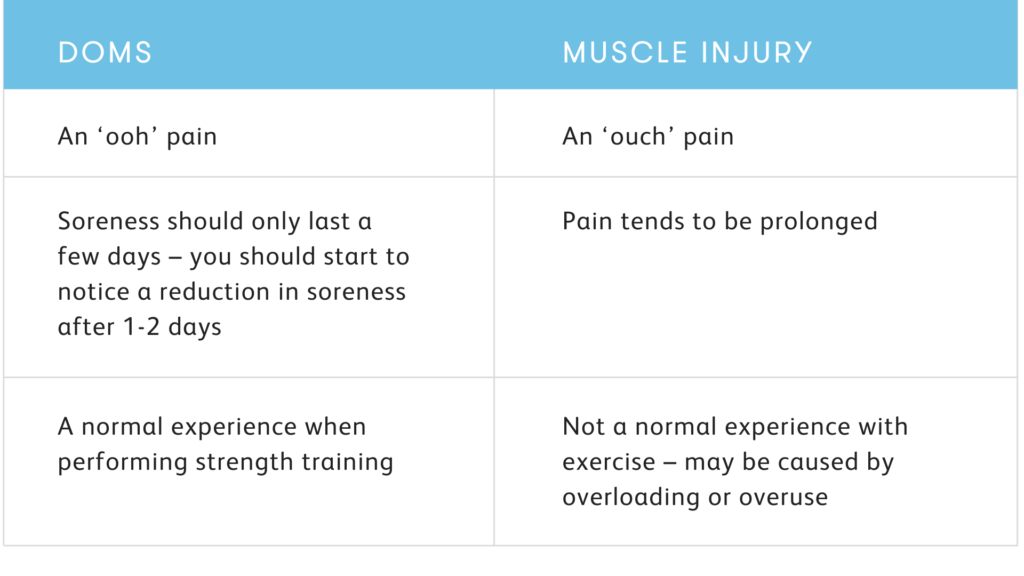
Stretching after a strength workout can assist with reducing the intensity of DOMS as well as prevent future injury by ensuring tight / exercised muscles return to their normal resting length.
Stretching time!
Each stretch has three variations ranging in intensity. Please choose the variation that is safe and appropriate for you. Aim to perform each stretch for the specific time/number of reps listed below. Stretching should be slightly uncomfortable but not unbearable.
1. Spinal rotations
Perform 5 times each side.
Seated thoracic rotations
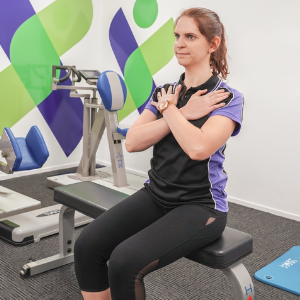
Sit on a chair with good posture, arms crossed over your chest.
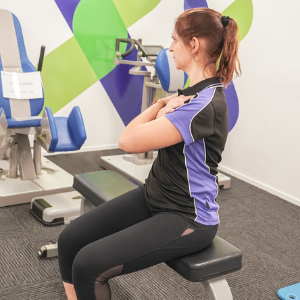
Keeping your hips still, twist your upper body to one side to the point of slight stretching/pulling.
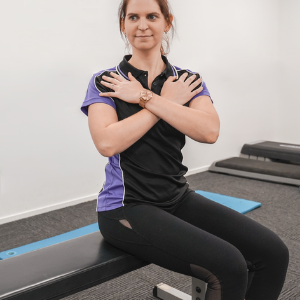
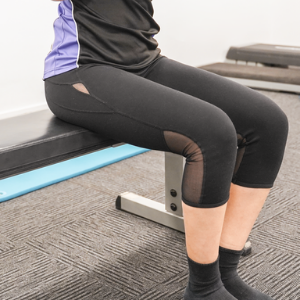
Pause then slowly repeat on the other side.
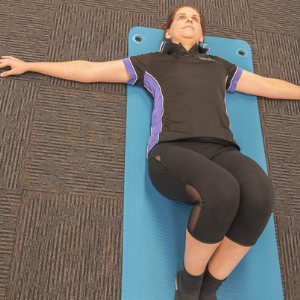
Knee rocks
Lay on your back in the hook-lying position (knees bent with feet flat on floor).
With ankles and knees together, rock your knees to one side, ensuring your shoulders remain on the floor. Pause then slowly repeat on the other side.
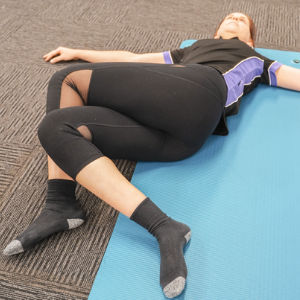
Cross-legged knee rocks
Lay on your back in the hook-lying position (knees bent with feet flat on floor). ‘With ankles and knees together, cross one leg over the other then drop to one side, ensuring your shoulders remain on the floor. Pause then slowly repeat on the other side.
2. Hamstring
Hold for 30 seconds, 1-2 times per side.
Seated hamstring (on chair)
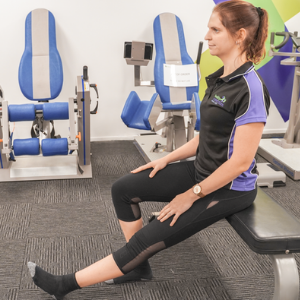
Seat towards the front of a chair with good posture. Straighten one leg in front of you with toes pointing up.
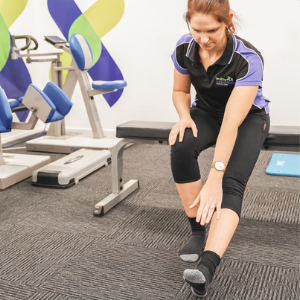
Keeping your back straight, bend forward at your hips and feel a stretch down the back of your leg. Hold this position.
Seated hamstring (on floor)
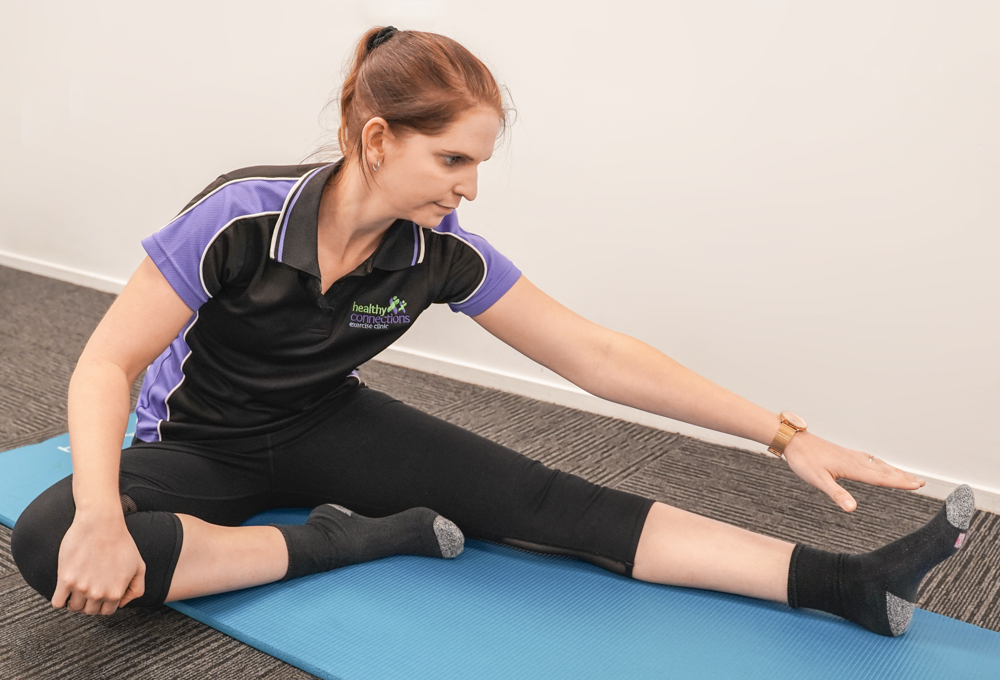
Sit upright on the floor with one leg straight and the other leg bent. Keeping your back relatively straight, bend forward at your hips and reach towards the toes of your straight leg. Hold this position.
Lying hamstring with strap
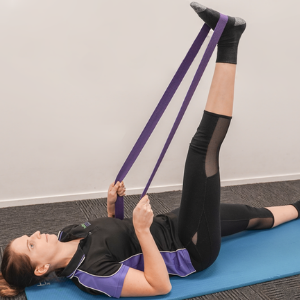
Lay on your back with your legs straight. Using a belt, rope, band or strap, wrap around the middle of one foot.
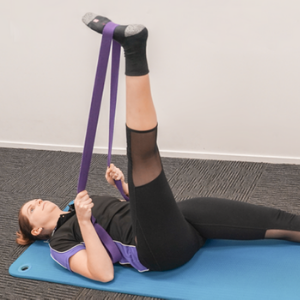
Lift your leg using the strap and keep as straight as possible. Pull your leg towards you to the point of slight discomfort. Hold this position.
3. Gluteal
Hold for 30 seconds, 1-2 times per side.
Seated
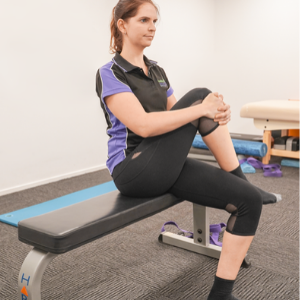
Sit on a chair with good posture.
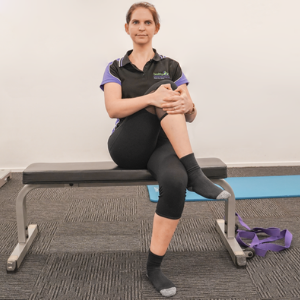
Cross one leg over the other and pull the bent knee up towards your chest and opposite shoulder. Hold this position.
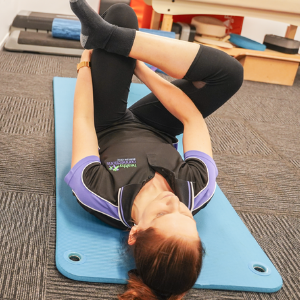
Pretzel (lying)
Lay on your back and cross one leg over the other. Lift your other leg and hold behind your knee. Hold this position.
Pigeon pose
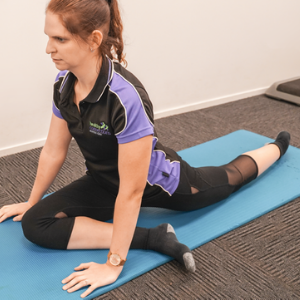
On all-fours, straighten one leg and bring the other knee up towards your hands. If able, sit back onto the hip of the bent leg.
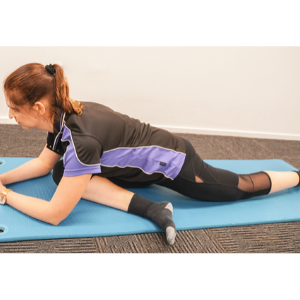
For a more intense stretch, bend forward at your torso and lay over your knee. Hold this position.
4. Lats
Hold for 30 seconds, 1-2 times per side.
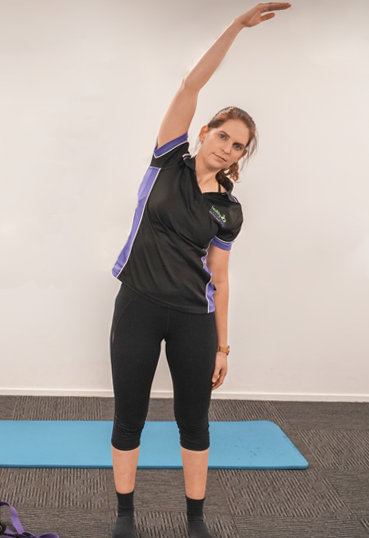
Standing side bend
Standing tall, lift one arm overhead and reach over to the opposite side, bending your torso. Hold this position.
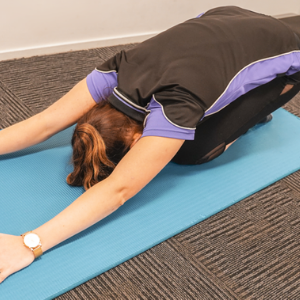
Child’s pose
On all-fours, sit back onto feet with arms outstretched in front of you. Hold this position.
Child’s pose palm up to the side
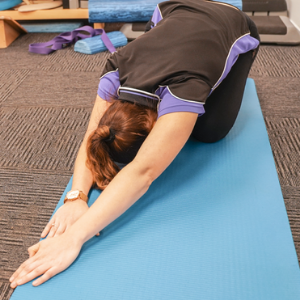
Assume child’s pose but place hands to one side as you sit back.
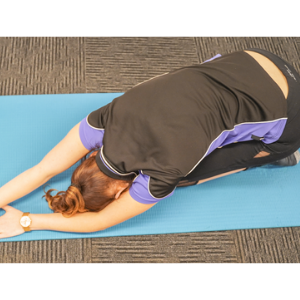
Feel a stretch down one side of your body. Hold this position.
5. Hip flexor / Quad
Hold for 30 seconds, 1-2 times per side.
Standing hip flexor using bench
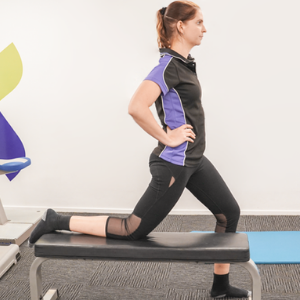
Place one knee on a bench or chair and step forward with your standing leg. Bring your hips forward and flatten your bottom.
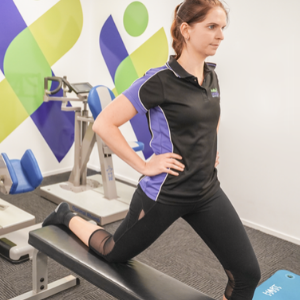
Feel a stretch in the top part of the hip of the kneeling leg. Hold this position.
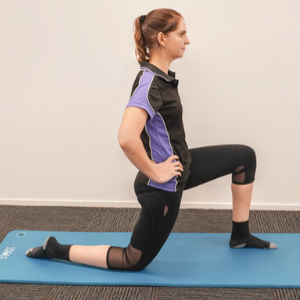
Kneeling hip flexor
Assume a half-kneeling pose with good posture. Bring your hips forward and flatten your bottom. You should feel a stretch in the top part of the hip of the kneeling leg. Hold this position.
Kneeling hip flexor + heel grab with strap
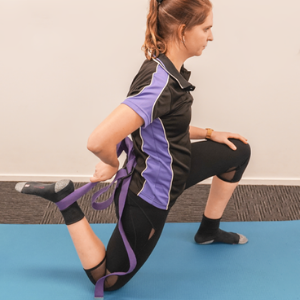
Assume a half-kneeling pose with good posture. Wrap a strap around your back ankle. Bring your hips forward and flatten your bottom whilst lifting your back leg up using the strap.
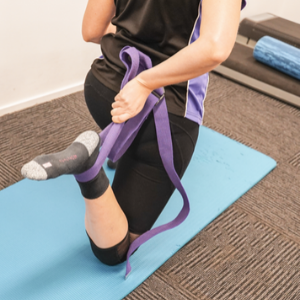
Feel a stretch all the way down your front thigh of the kneeling leg. Hold this position.
6. Calf
Hold for 30 seconds, 1-2 times per side.
Standing calf
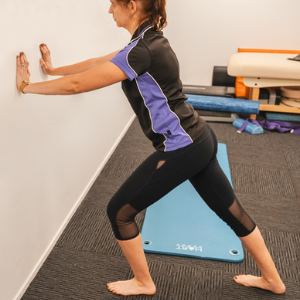
Standing with your hands against a wall, stand with a split stance (one foot in front, one foot back). Bend your front knee while keeping your back leg straight and heel on the floor.
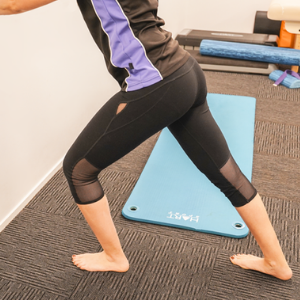
You should feel a stretch down the calf of your back leg. Hold this position.
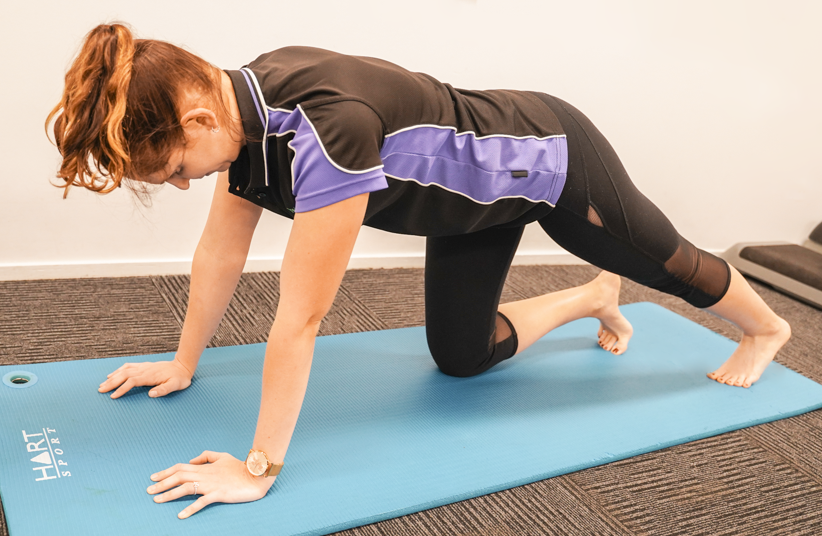
Kneeling calf stretch
On all-fours, straighten one leg out and place toes on the floor. Try to pull your heel away from your knee to feel a stretch through your calf. Hold this position.
Downward dog calf stretch
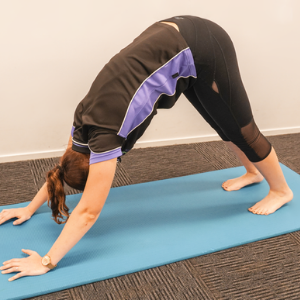
On all-fours, lift your hips and knees off the floor into a downward facing dog pose (hips up with arms and legs straight).
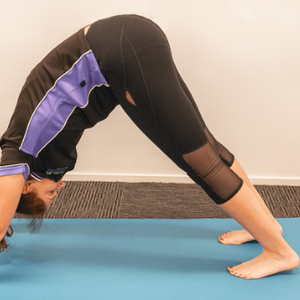
Try to place your heels towards the floor to feel a stretch through your calves. Hold this position.
7. Chest
Hold for 30 seconds, 1-2 times per side.
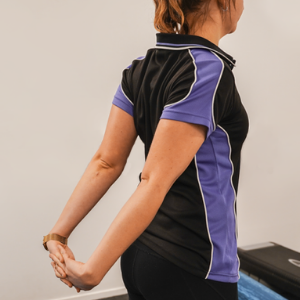
Standing chest opener
Stand with good posture. Interlock your fingers behind your back and broaden your chest. Feel a stretch across your chest. Hold this position.
Doorframe stretch
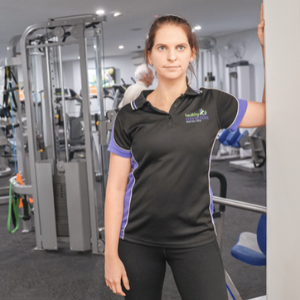
Using a doorframe, place forearm on the edge of the doorframe. Your elbow should be no higher than your shoulder.
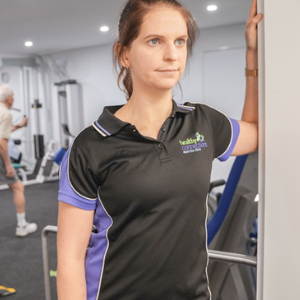
Take a small step forward and lean forward and away from the doorframe. Feel a stretch across that side of your chest. Hold this position.
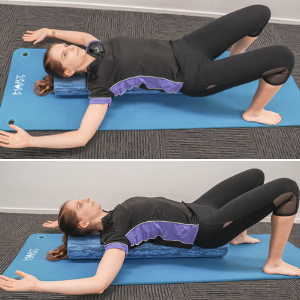
Lying chest over foam roller
Lay on your back with a foam roller or pool noodle along your spine and feet flat on the floor (remember to support your head with a rolled up towel). Lift your arms above you then lower towards your head. With elbows slightly bent, lower your arms down by your sides slowly, letting gravity press your elbows down towards the floor. Stop at a position where you feel a stretch across your whole chest. Hold this position.
If you have any questions about these stretches, please comment below or ask one of our exercise physiologists at Healthy Connections.
Thanks for reading, stay safe and keep moving (and stretching!).
Sophie
References
- Arthritis Foundation of WA. (2017). Winter and Arthritis. Retrieved from https://www.arthritiswa.org.au/condition/winter-and-arthritis/
- Ehrman, J. K., Gordon, P. M., Visich, P. S., & Keteyian, S. J. (2013). Clinical Exercise Physiology. Human Kinetics: Champaign, IL.



